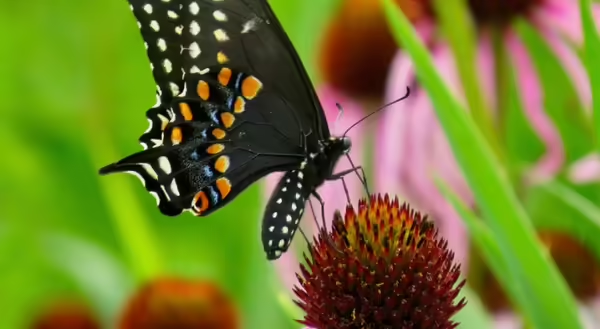
Are you ready for a break from the garden? Breaking some old habits in your usual fall garden clean up could make a huge difference to butterflies, moths, bees, and other beneficial insects that overwinter in the Illinois landscape, and be a more environmentally sound practice.
Bad habit 1 - Removing all fallen leaves
The first habit to break is removing all the fallen leaves from your landscape. Leaves provide insulation for overwintering insects, plus organic matter and nutrients that would otherwise end up on the curb. Leaves from healthy trees can be used to mulch your beds, or incorporated into your lawns and garden soils.
Shred the leaves beforehand to prevent them from forming an impenetrable mat which keeps moisture and air from reaching the soil surface, causing lawn dieback. They are also less likely to blow down the street after they have been shredded. To shred directly into your lawn, mow over them until chopped up into small pieces. This may take more than one pass.
A few ideas for shredded leaves:
- Mulch beds 3 to 6inches deep around perennials, trees, and shrubs.
- Incorporate shredded leaves into the soil of vegetable gardens. Adding fertilizer will speed up the process of breaking down leaves before spring.
- Leaves can be saved and set aside in bags and used as the browns for composting with your green kitchen scraps.
- Avoid using black walnut. A chemical component of black walnut leaves, juglone, prevents growth in certain plants.
Bad habit 2 - Cutting back perennial forbs in the fall
In the fall, perennial forbs are still hosting life and providing soil nutrients, despite the browning of leaves from the frost. Silvery checkerspot butterflies overwinter as caterpillars in brown skins at the base of their host plants, Black-eyed Susans, coneflower, and sunflowers. Black swallowtail butterflies who dine on your dill, fennel, parsley, and carrots overwinter as a brown chrysalis that mimics an old fallen leaf.
Author and native plant expert Heather Holm waits to cut her perennials back to 15 inches in late spring, making an accessible nesting cavity for some bees and wasps. Roy Diblik, author and perennial plant expert, suggests the mowing of perennial beds leaving the debris in the garden to act as leaf mulch before the bulbs arrive.
Although it may be hard to break the habit, using fallen leaves as mulch and leaving your garden stems intact will benefit insects and improve soil health. However, not all plants should be kept in the garden. Be sure to remove any diseased and damaged plant tissue to keep your garden on a healthy trajectory.